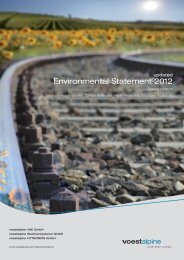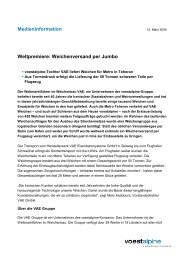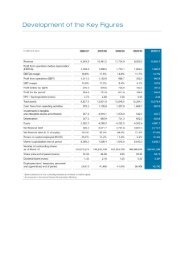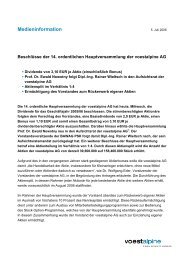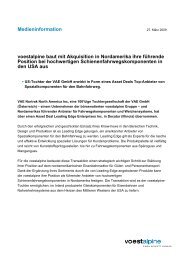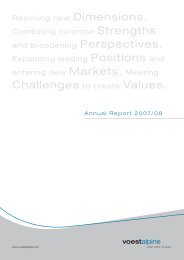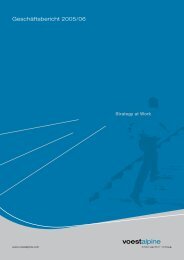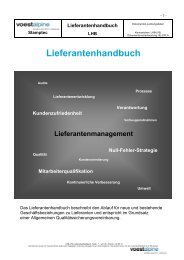Annual Report 2005/06 - voestalpine
Annual Report 2005/06 - voestalpine
Annual Report 2005/06 - voestalpine
You also want an ePaper? Increase the reach of your titles
YUMPU automatically turns print PDFs into web optimized ePapers that Google loves.
FinanCial insTrUmenTs<br />
liquidity risk – Financing<br />
The liquidity risk indicates the ability to raise<br />
funds at any time to clear liabilities.<br />
The essential instrument for controlling the<br />
liquidity risk is a precise financial plan,<br />
which, ensuing from the operative companies,<br />
is submitted quarterly directly to the<br />
Group treasury of <strong>voestalpine</strong> AG. A tool<br />
developed by the Group for long-term<br />
financial planning locates any financing<br />
gaps. The funding requirements and bank<br />
credit lines are determined from the consolidated<br />
results.<br />
Financing of operating funds is carried out by<br />
the Group treasury. A central clearing system<br />
implements a daily intra-group financial<br />
equalization adjustment. Companies with<br />
liquidity surpluses put the funds indirectly at<br />
the disposal of companies with liquidity<br />
requirements. The excess is placed with the<br />
principal banks by the Group treasury. In this<br />
way a decrease in the volume of borrowings<br />
and an optimization of the net interest<br />
income are achieved.<br />
The sources of financing are selected on the<br />
basis of the principle of bank independence.<br />
Financial relationships currently exist with<br />
about 25 different domestic and foreign<br />
banks.<br />
Credit risk<br />
Credit risk describes losses which can occur<br />
through non-fulfillment of contractual obligations<br />
of individual partners.<br />
Consolidated Financial Statements<br />
The credit risks of the underlying transactions<br />
are kept low by precise management of<br />
receivables. Roughly 70% of the underlying<br />
transactions are hedged through credit<br />
insurance. In addition, there are bank<br />
securities (guarantees, letters of credit).<br />
Internal guidelines regulate the credit risk<br />
management of financial transactions. The<br />
minimum rating for investments in securities,<br />
for example, is AA- according to Standard &<br />
Poor’s. Furthermore, all investments and<br />
derivatives transactions are limited per contracting<br />
party, meaning that the amount of<br />
the limit depends on the rating and the<br />
amount of equity of the bank.<br />
The credit risk for derivative financial<br />
instruments is limited to transactions with a<br />
positive market value and, of these, to<br />
replacement costs. Therefore derivatives<br />
transactions are only valued at 20% of the<br />
limit (30% in the case of cross-currency<br />
swaps). Derivatives transactions are almost<br />
exclusively based on standardized global<br />
contracts for financial futures.<br />
price risk<br />
Determination of price risk: To quantify<br />
interest and currency risk, <strong>voestalpine</strong> AG<br />
utilizes the value-at-risk concept.<br />
The maximum loss potential within the next<br />
business day and within one year is determined<br />
with 95% certainty. The correlations<br />
between the individual currencies are taken<br />
into account. Interest rate management also<br />
utilizes the present-value-basis-point-method.<br />
<strong>Annual</strong> <strong>Report</strong> <strong>2005</strong>/<strong>06</strong>





